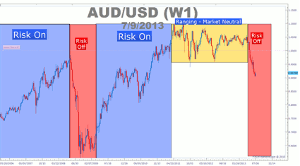A few years ago, forex traders needed to know only a few things to have a good grasp on market direction, and while those days took a yearlong vacation, they appear to be back and it would benefit you greatly to get familiar with them again, writes Tyler Yell of DailyFX.com.
A few short years ago, not long after the credit crisis of 2008, forex traders only needed to know a handful of terms to have a good grasp of the market. Two key terms were the “risk-on” or “risk-off” trade that could allow you to categorize your trade plans effectively. Then, out of nowhere, a few central banks stepped up and the game seemed to be over for a short while, but now it’s back.
A “Risk-On” “Risk-Off” Primer
In 2009-2011, traders focused on the AUD/USD or EUR/AUD as the primer for the “risk-on” or “risk-off” trade. In short, the “risk-on” environment was characterized by rising stock markets and commodities and a falling US dollar as traders were exiting the safer US Treasuries in search for yield. The “risk-off” trade was the opposite of “risk-on” as the US dollar showed immediate strength when traders fled away from stocks and commodities in fear of another 2008 re-emerging.
AUD/USD Has Been the Classic Risk-On/Risk-Off Barometer

Presented by FXCM’s Marketscope Charts
Click
to Enlarge
The reason for this correlation is that the Australian dollar has been overexposed to the “Chinese Growth Miracle” and is largely at the mercy of China’s rises and falls. When times were good and the global economy was sailing smoothly, the AUD rose promptly. However, when things got ugly in terms of fundamental data, Australia’s exposure to the Chinese industrial sector caused the AUD to drop along with other major asset classes like commodities and specific indices.
How “Risk-Off” Could Reemerge & Affect Your Trading for 2013
A few days ago, the International Monetary Fund (IMF) came out and lowered their global GDP forecasts for the quarter to 3.3% from 3.1%. Big cuts were given to euro-area growth, which could come before a big drop in the EUR if it becomes one of the weaker currencies in the G7.
On top of that, last week, two ominous tones came out of the European Central Bank (ECB) and the Bank of England (BoE). Specifically, Mark Carney, the new head of the Bank of England clearly stated that “The implied rise in the expected future path of [the] bank rate was not warranted by the recent developments in the domestic economy.” This is central banker speak for stating that he doesn’t believe the fundamental data supports a high price in the GBP and if the head of the central bank doesn’t see a reason for the GBP rising, then you shouldn’t either.
NEXT PAGE: Risk-On Trades Not Applicable Now
|pagebreak|Also in tune was a sour economy in Europe and further striking the “risk-off” chord was an easy money statement. Specifically, Mr. Draghi, the president of the ECB, said that rates shall likely remain low “for an extended period of time,” which were likely the most disheartening words to euro bulls. The pound and the euro have sold off 450 & 250 pips respectively since those comments last week.
The Risk-Off Trades: Long USD Against Majors or USD Basket – Buy USD Strength Across the Board

Presented by FXCM’s Marketscope Charts
Click
to Enlarge
When institutional traders get scared, they run away from risk. The seemingly safest play to run away from risk and into apparent safety are US Treasuries, which help traders know that at the very least, their money is safe even if its not bringing the returns they wish. Naturally, this transfer of global assets into US Treasuries results in a mass buying of the US dollar and US strength. This has played out recently as major central bank leaders have talked down their currency as Bernanke could possibly slow down the easing efforts on the US dollar.
While the US dollar is the favorite for now, keep your eyes on the Economic Calendar. If news for the US dollar begins to mirror the rest of the global economy, you could see traders dump the USD along with the EUR, GBP, and AUD. If that happens, the JPY basket-buy may become the most appropriate trade across the board.
The Risk-On Trades: Currently Not Applicable in FX
When the risk is on, a favorite play is often to short the Japanese yen as traders from that part of the world who were once concerned about safety now hunt yield. For an eight-month span of October 2012-June 2013, this play was on as the JPY weakened and the Nikkei 225 (Japan’s equivalent of the Dow Jones) strengthened. Another option is to sell USD across the board or open a USD basket-sell but that would not work well in the current environment.
Closing Thoughts
The beauty of trading in a clear “risk-on” or “risk-off” world is that the trades become clear. In a “risk-on” environment, the USD and JPY are sold by the masses as they seek higher yielding plays for their portfolio with other major currencies. In a “risk-off” environment, you’re looking for simple entries in the direction of the trend, which is currently buying the US dollar.
By Tyler Yell, Trading Instructor, DailyFX.com





















